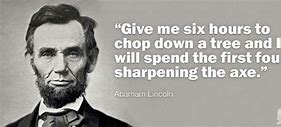Article-Detail

Stay Sharp
Abraham Lincoln once said, “If I had six hours to chop down a tree I’d spend four sharpening my axe”. As leaders are very aware, your success is always in the preparation. I tell the people who I mentor that the best response to anxiety, that uncomfortable feeling you get before you take on a difficult task, is preparation. When it comes to getting things done, preparation is everything. In the context of leadership, preparation for getting things done is the cultivation and maintenance of your relationships. Depending on your role in your organization, you could lead thousands of people who occupy roles in many departments or you could lead a small team. Whatever your position or your objectives, your preparation will determine your ability to get things done and move your organization forward.
I serve as a Human Resources Director in a district in the San Francisco Bay Area responsible for educating 30,000 students at 55 schools. Ultimately it is the responsibility of our five School Board Trustees to educate those children but that is far too daunting a task for five elected officials. Since they are politicians and not educators they must hire someone to be responsible for educating the children they serve so they hire a secretary, more commonly known as the Superintendent. Educating the 30,000 kids is now his job which is more daunting because the five board members lay their responsibility at the feet of one person. He looks at his task of educating kids and says to himself, “I need a team to hire and manage teams who will hire and manage teams who will ultimately deliver a world class experience to my kids”. He hires a senior executive team (cabinet), who hires middle managers (directors and coordinators) who hire principals who hire teachers and support staff to educate kids and maintain all district property. This is a common structure whether it is a school district, Fortune 500 Company or a local water board. People sharing responsibility with other people.
Now that the team is in place, the challenge is getting them to know what is expected of them and getting them all moving in the same direction. This is the fun and frustrating part of leadership mainly because this team did not come off of an assembly line with the exact specifications that you need. Instead they come with their own experiences, biases, needs and strengths. Coming to the realization that your people are unique individuals will help you to accept their shortcomings and support their success without resentment or anger. In September of 2011, NBA Hall of Fame Coach, Phil Jackson appeared in an Audi commercial where he interrupts a chef berating one of his cooks saying, “Anger is the enemy of Instruction”. His character points out that the chef’s approach of excoriating an employee who makes a mistake is the least effective way of teaching someone how to do their job.
A question I like to ask is, “Have you ever berated someone to greatness?” Over 95% of the time the answer is “No”. So what is the best way to get people to do the work that the organization is responsible for? The answer is what I like to refer to as the MIC, which is to Motivate and Inspire Constantly. Dale Carnegie writes in his book, How to Win Friends and Influence People, the only way to get people to do things is to make them want to do it. There is no other way. Certainly, if you don’t motivate your people, they will still get things done but it is a crap shoot as to whether they will care to do it right or to your standards unless you can get them to want to do it.
That being said, back to the six hours President Lincoln used to sharpen his saw and what that means to you. Organizational psychologists will tell you that your people will not buy into what you’re telling them, they will buy into you. Further, you can’t do the work without them because 30,000 students are too many for one man to educate so you get your work done through them. If you are the type of leader that can make them feel good about themselves, they will care about you, and your mission, and vision. Getting them to care is the key to moving them in the right direction. People ask me, “That’s great but how is that done?” You turn your attention from the people outside of the organization and focus intently on the people inside the organization. From the time you accept the assignment to your first formal acts to tackling the biggest challenges, your people and their needs are your first priority.
Your people are constantly developing a narrative on you. From the time your name is announced to your first interaction with any one of them to the way you respond to the pressures of your job, people are always watching, assessing and adding to their own narrative about you. Do not, I repeat, do not sleep on the value of first impressions. Your first impressions are critical because people make assessments on you in less than a quarter of a second. Confirmation bias tells us that, to prove themselves correct, people will spend the rest of their relationship with you looking for your qualities that support their first split second assessment. So pay close attention to that moment in time. When the pressure is on exude a calm confidence. Share information with your people and ask them how they are feeling and how they might approach challenges. You will build boatloads of trust because you kept your cool and you demonstrated that you valued them and their opinions.
Now that you have been announced, introduced and are getting into the rhythm of the work, the time has come to celebrate your people. One of the biggest fables you will hear at work is this, “I come to work to do my job and then go home”. We have all heard it and I have a challenge for you. Seek out the people you hear saying this, find a time to make a big deal about one of their accomplishments and do it in front of the team. What I have found is that acknowledgement means a great deal to people who complain the most. Do not waste an opportunity to say, “well done” or “good job” or “I like how you… “. That feels good and is a powerful motivator for people. Share credit. Anytime your team accomplishes something slather the credit all over them.
One key to successful leadership is making your people feel good about themselves so they feel good about you, your mission and your vision. It is difficult to build trust, concern and confidence in your people if they do not know that you are behind them supporting and encouraging them. Essentially, you are cutting down trees all day at your workplace, and at the same time you are sharpening axes. If you can develop a rhythm and consistency in your behavior, they will want you to succeed and will go out of their way to see you shine. Bottom line, when they shine so will you. Keep grinding that axe and SOAR.
William A. Brown
January 13, 2019
Resources you might find Interesting
It Worked for Me: In Life and Leadership by Colin Powell
Leaders Eat Last: Why Some Teams Pull Together and Others Don’t by Simon Sinek
https://academictips.org/blogs/the-story-of-a-woodcutter/




